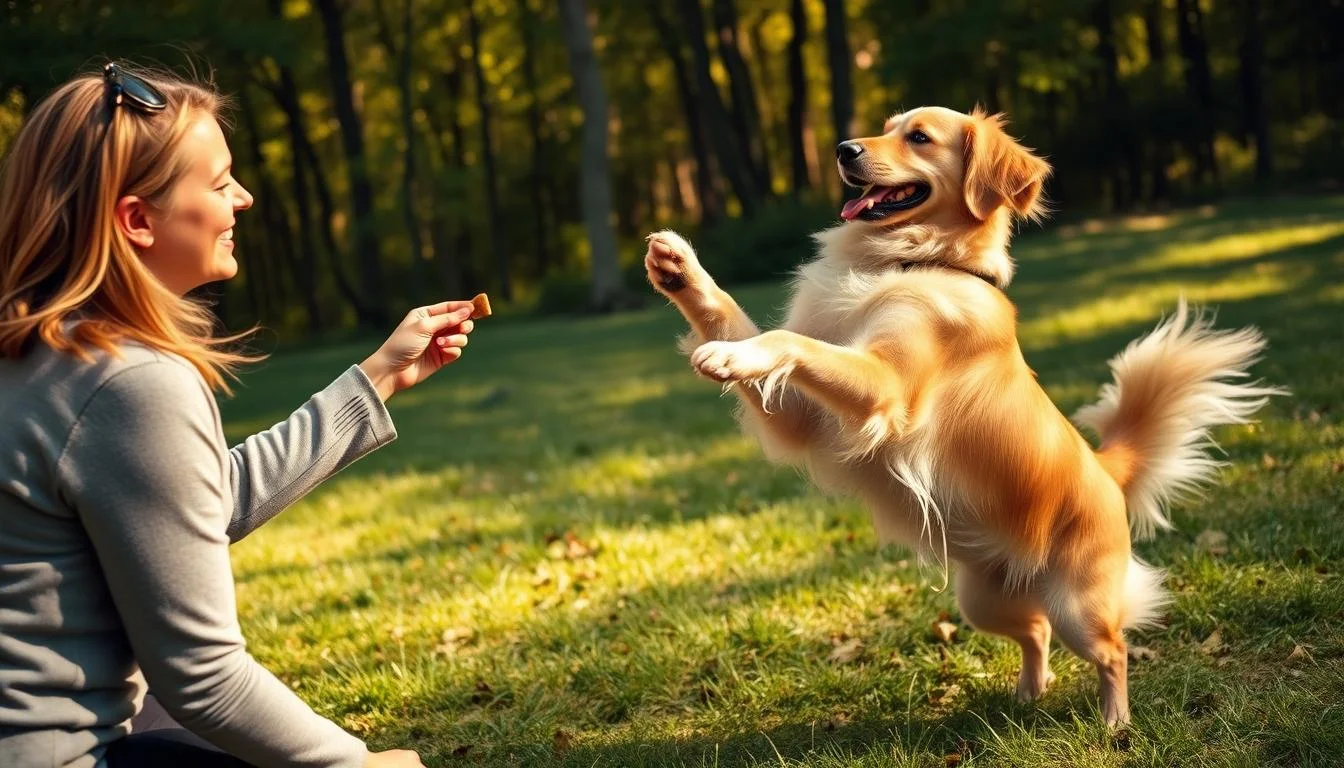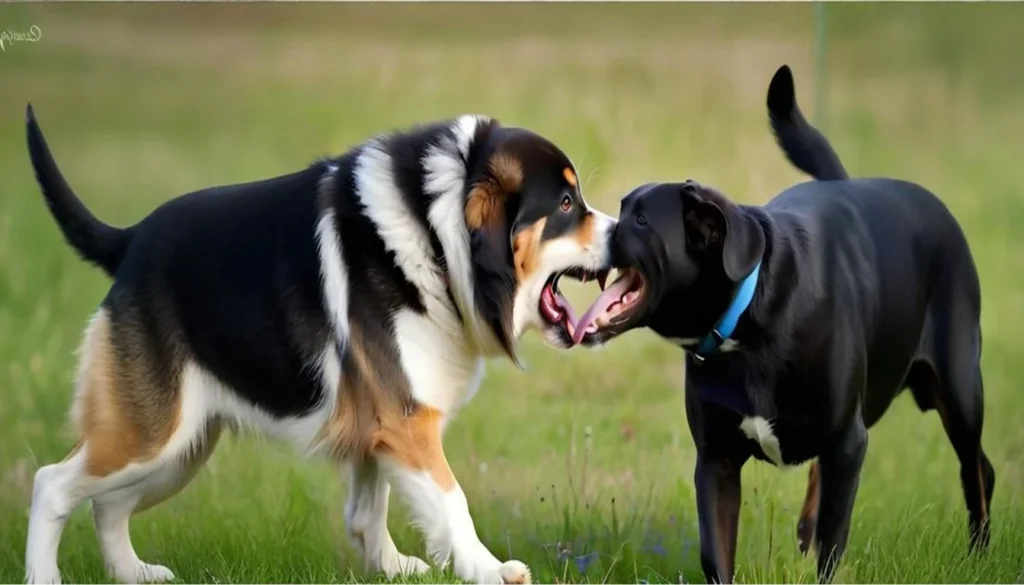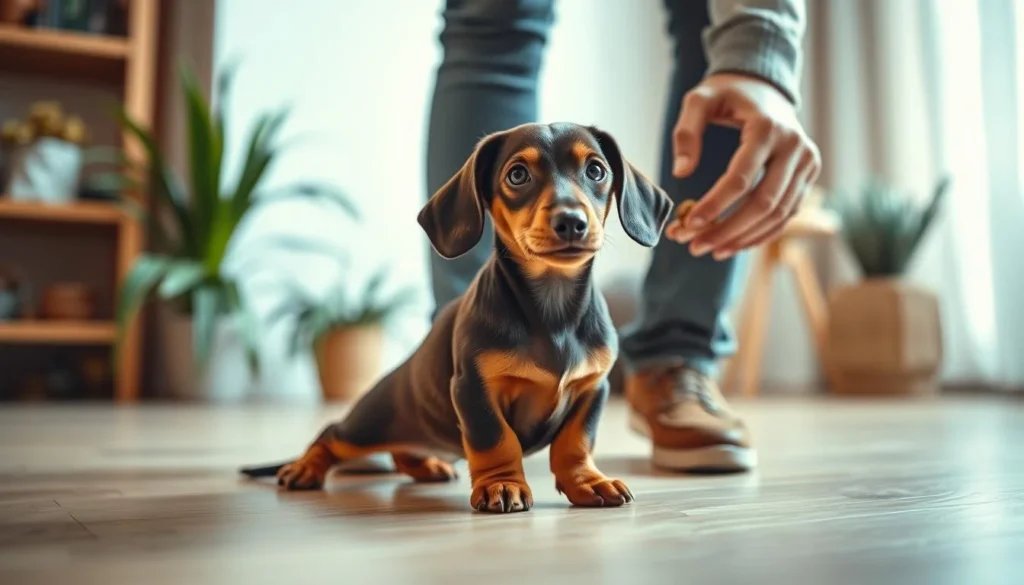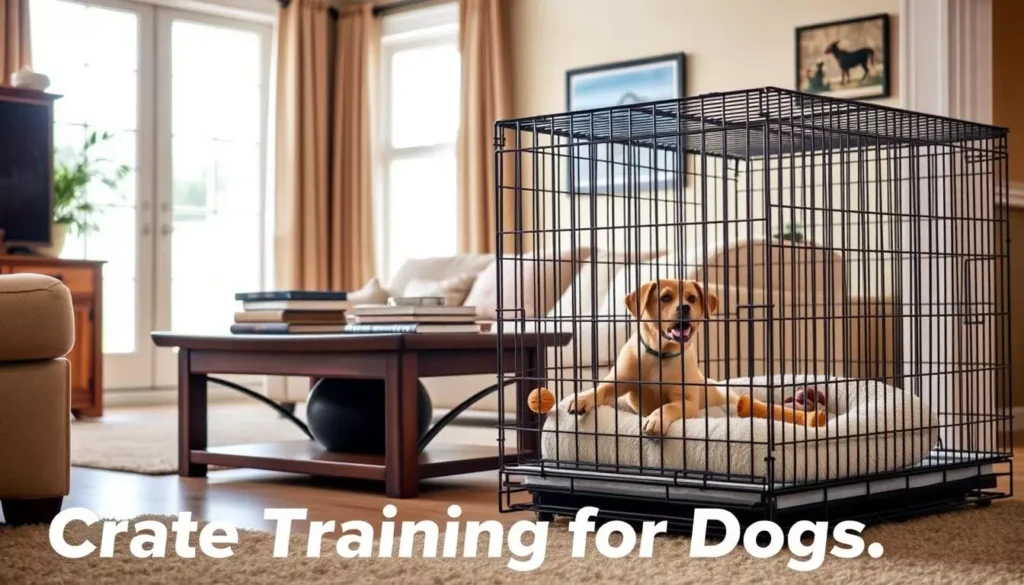I remember the first time my Labrador leaned on my elderly mother. It sent her glasses flying across the kitchen. The dog was showing love, but it was dangerous. This moment made me look for ways to stop dogs from jumping up.
Jumping is a common greeting for dogs. They want to be close and get attention quickly. Without training, this habit can last into adulthood. My goal is to keep everyone safe and teach dogs not to jump up.
This guide offers four main strategies. First, teach a new behavior to replace jumping. Next, manage the environment to prevent jumping. Reward your dog for sitting instead of jumping. Finally, practice these steps gradually to get the best results.
Key Takeaways
- Jumping is a natural greeting but can be unsafe; early habits stick.
- Teach an incompatible behavior like sitting to replace jumping.
- Use management and setup to prevent practice of the unwanted behavior.
- Reward four-on-the-floor immediately to reinforce polite greetings.
- Progress gradually from familiar people to strangers for reliable results.
Why dogs jump up and the behavior science behind greetings
Dogs often jump up as a natural way to greet. They want to be close and sniff each other's faces. Puppies learn that jumping gets a reaction from humans, making it a way to get attention.

Natural reasons dogs jump to greet
Dogs see humans as they would another dog, and they want to investigate. This is why they jump up when someone arrives. It's not because they're being rude, but because it's their way of saying hello.
How reinforcement maintains jumping
Any attention, good or bad, can make a dog jump more. The American Kennel Club says even scolding can be seen as play. This means that dogs learn to jump because it gets a reaction.
Why size and context matter
Size is important because a big dog can hurt someone, while a small one might scratch. Training is different for each situation. It's important to teach dogs not to jump in public or at home.
Set clear greeting rules and teach an incompatible behavior
I start by picking one clear rule for greetings so my dog knows what to do instead of what not to do. A chosen rule like four-on-the-floor, sit-for-greetings, or “go to place” gives a simple, repeatable action. The American Kennel Club and many trainers recommend giving dogs a specific behavior to perform when people arrive.
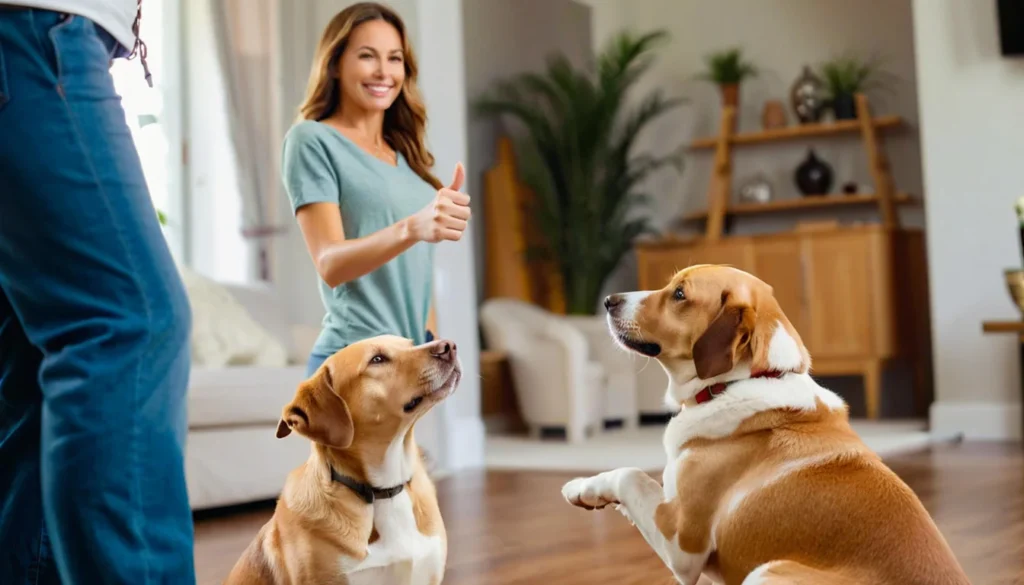
Choose a greeting rule that fits your household
I consider family routines, visitor flow, and the dog’s age when I choose a rule. For an active puppy, short sessions and high-value treats work best. If space is tight, “go to place” keeps the dog out of the entryway. If guests want photos or hugs, sit-for-greetings reduces chaos and keeps everyone safe.
How incompatible behaviors stop jumping
Teaching an incompatible behavior gives the dog a physical alternative to leaping. A sit or keeping all paws on the floor cannot happen at the same time as jumping. When I teach how to train a puppy from jumping up on you, I pair the new behavior with rewards the dog cares about. Over time the dog learns that a calm action earns attention faster than jumping.
Consistency across family and guests
All household members must use the same rule every time. I ask friends and delivery people to ignore the dog until permission is given. Using a leash, baby gate, or crate at the door prevents accidental practice of the old habit. That way training dog to not jump becomes a group effort and stays effective.
dog training tips for jumping up
I guide you through simple steps to stop your dog from jumping. We'll work on polite greetings. Use quick rewards, calm withholding of attention, and simple tools to manage the behavior while your dog learns.
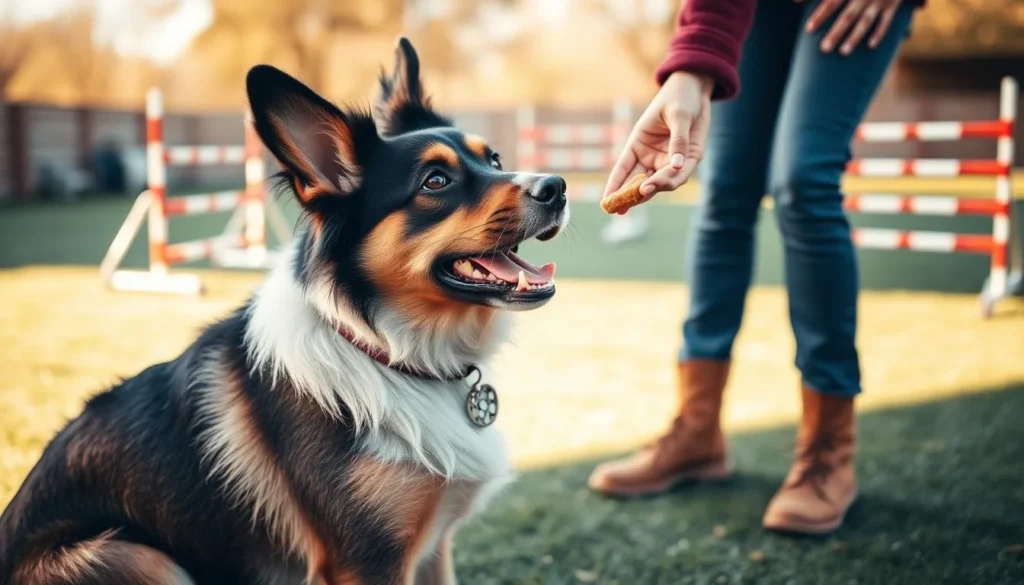
Reward four on the floor immediately
When your dog's front paws touch the floor, give them attention and a quick pat right away. The American Kennel Club says dogs repeat behaviors that get attention, so timing is key.
Have treats or a soft touch ready. Quick, consistent rewards make the new behavior stronger than the old habit. This helps stop your dog from jumping on people.
Remove attention when the dog jumps
If your dog jumps, turn away or step out of reach to take away social reward. Avoid pulling, pushing, or kneeing as it still gives attention and can harm trust.
Quietly walk away until your dog settles. This makes jumping unrewarding and helps prevent future jumping in greetings.
Use treats and management to set up success
I use treats on the floor or a leash and baby gate at entries to stop jumping. These short-term tools help control rehearsals while teaching better habits.
Give treats before your dog jumps, then slowly reduce them as they learn to stay on all fours. This method stops jumping without harsh corrections.
| Action | Why it works | How I apply it |
|---|---|---|
| Immediate reward for all fours | Reinforces polite greeting quickly | Treat or pet within one second of all fours |
| Remove attention for jumps | Makes jumping non-rewarding | Turn away, step back, hold position until calm |
| Use management tools | Prevents rehearsal of bad habits | Leash, baby gate, scatter treats, tether at doorway |
| Fade rewards over time | Builds lasting manners | Gradually reduce treats, keep intermittent praise |
Train sit and four-on-the-floor for polite greetings
I teach dogs to greet politely by breaking it down into small steps. Start calm, use a short leash, and keep sessions short. This method is great for teaching dogs to jump on command and not jump up too much.
I start with the dog a few feet away, tethered. I ask for a sit. If they sit, I walk towards them, rewarding them with a treat and praise. If they jump or try to run, I go back to the start and ask for sit again.
I do short training sessions, making my approach a bit more exciting each time. This teaches control and builds confidence in dogs.
Practical four-on-the-floor training with treats
With the dog on leash, a helper approaches. They throw small treats on the floor just before they reach the dog. This way, the dog sniffs and eats instead of jumping up. I reward calm behavior right away and give out treats often at first.
Once the dog is good at this, I make the greetings longer and give out fewer treats. My goal is to make the dog rely on praise and attention instead of treats. This method helps dogs learn to jump on command and not jump up too much.
Progression from familiar people to strangers
I start with family members, who are less exciting for the dog. When the dog greets them well, I introduce friends, then acquaintances, and finally strangers. I tell visitors to ignore the dog until I say it's okay.
On walks, I use a "watch me" cue or a toy to keep the dog's attention until they greet politely. These small steps make training easier and keep the dog's behavior consistent around different people.
Management tools to prevent practice of jumping
I make sure my dog can't practice jumping. Short sessions at the door are best. I keep it simple so everyone can follow it.
I use barriers and leashes to control access. A clipped leash or baby gate keeps my dog away. This lets me reward calm behavior.
Use physical management at the door
I tether my dog to a stable anchor or use a closed gate. I also have a slip lead by the door. These steps help train my dog and make visits less stressful.
Use signage and training harnesses
I post signs to warn guests. I use a front-clip harness from Ruffwear or PetSafe. It helps me control my dog's movements.
Front-door practice and environmental setup
I practice at the real door. I start with quiet rehearsals, then add a doorbell sound. I place treats and toys near the entry but toss them away from the door.
I keep sessions short and predictable. I ask family to follow the same steps. This way, my dog learns to be calm at the door.
Behavior modification techniques and reinforcement strategies
I start by setting clear expectations and a simple plan. When guests arrive, I use management to prevent jumping. Then, I train the dog to greet calmly and reward them for it. This section covers schedules, cues, and what to do when progress stalls.
Positive reinforcement schedules and fading treats
I start with continuous, high-value rewards for good behavior. This helps the dog connect the action with a great outcome. Once they reliably greet calmly, I switch to a variable schedule.
I then fade treats for jumping. I keep occasional treats and attention to keep the dog engaged.
I check progress often and adjust criteria slowly. If a session goes well, I extend the time or add more distractions. When fading treats, I use social praise and petting to keep the dog wanting to cooperate.
Using cue words and markers
I use a clear cue like “sit” or “four on the floor” and a consistent marker word or clicker. This gives instant feedback. A precise marker helps the dog know exactly which action earned the reward.
I pair the cue with the marker until the behavior is solid. Then, I phase out the marker and rely on intermittent rewards. This supports long-term dog behavior modification for jumping up.
How to handle setbacks and accidental reinforcement
I expect mistakes and keep calm when they happen. If a guest accidentally rewards jumping, I redirect without scolding. I re-teach the rule with higher management and more frequent rewards.
When setbacks occur, I return to easier steps, increase supervision, and raise reinforcement frequency. I do not use physical punishment. Teaching people how to act at the door helps prevent accidental rewards and shows how to handle setbacks in dog training.
Teaching controlled jumping and tricks as an alternative (optional)
When a dog has lots of energy and loves to jump up, I offer a controlled option. Teaching a clear trick helps the dog use their energy wisely. It also helps me set clear limits for greetings.
I start by breaking the move into two simple behaviors. First, I teach the action I want on cue. Then, I teach the opposite so the dog knows when to stop. This makes jumping safe and reliable.
Train a jump-up on cue and an off cue
I start with a low jump target like a small box or my knee. I capture the movement, mark it, and reward it. Short sessions keep the dog motivated. While practicing, I use high-value treats and repeat small reps.
Once the dog jumps easily, I add a clear verbal cue and a distinct hand signal. I practice in calm settings before adding distractions. To finish, I teach a firm jump off cue and reward immediate compliance.
Why I might teach jump and off for safety and clarity
Teaching both behaviors reduces accidental greeting jumps. A trained jump only happens on cue, preventing surprises for guests. Controlled jumping is a safe way to release energy during play or agility work.
This method is useful for public performances or sports. It keeps trick time separate from daily manners. This distinction keeps greetings polite at home.
Transitioning from trick to everyday manners
After the jump and off cues are solid, I start to fade the jump cue during normal arrivals. I reinforce four-on-the-floor or sit for greetings instead. This prevents the dog from turning the trick into every encounter.
I keep trick practice short and scheduled. I avoid rewarding jumping in casual interactions. With this structure, the dog learns when to jump and when to be polite.
| Step | Action | Goal |
|---|---|---|
| 1 | Introduce low target and reward for lifting front paws | Build shape for how to train dog to jump safely |
| 2 | Add a unique verbal cue and hand signal | Teach a reliable teach jump up on cue |
| 3 | Train an immediate, consistent jump off cue with reward | Establish a clear jump off cue for safety and control |
| 4 | Practice in varied locations with mild distractions | Generalize controlled jumping and build reliability |
| 5 | Fade jump cue from everyday greetings and reinforce sit/four-on-floor | Move trick into a separate activity; maintain polite manners |
| 6 | Schedule short trick sessions and keep them fun | Sustain training progress and enjoy dog training tricks safely |
Practice plans, baby steps, and building duration
I create simple jumping practice plans for busy schedules. Short, frequent drills work better than long ones. Each drill is under five minutes, done several times a day for steady progress.
To stop jumping, I break it down into small steps. Start with a single calm greeting at the door. Then, add another calm greeting. Only praise and reward when the dog stays calm or sits.
Training duration increases slowly. Begin with a two-second hold, then five, then ten seconds. When consistent, increase the time and use fewer treats. If focus is lost, shorten the next session and go back to a reliable step.
Design short repeated practice sessions
- Warm-up: one minute of leash attention work.
- Practice: three short door greetings with low distraction.
- Cooldown: quiet praise and a brief toy play.
Use progressive distance and distraction building
- Start with a family member approaching slowly from two meters away.
- Gradually reduce distance and speed of approach over sessions.
- Add distractions like a ringing doorbell or a delivery person only after basics are solid.
Reward criteria and measuring success
- Set clear reward criteria for greeting: ten calm, four-on-the-floor greetings in a row or five sits through an open door.
- Record sessions in a simple log to track steady gains and setbacks.
- Shift to intermittent rewards as reliability grows while keeping praise consistent.
| Phase | Session Length | Goal | Reward Criteria for Greeting |
|---|---|---|---|
| Intro | 2–3 minutes | Attend to handler, one calm greeting | Single calm four-on-the-floor |
| Build | 3–5 minutes | 3 calm greetings in a row | Three consecutive calm greetings |
| Generalize | 5–8 minutes | Hold position with distractions | Ten calm greetings across contexts |
| Maintain | 5 minutes, periodic | Reliable manners with reduced treats | Consistent sit or four-on-floor; intermittent treats |
Conclusion
I remind you of the simple steps to stop your dog from jumping. First, decide on a clear rule, like sitting or staying. Then, teach an incompatible behavior and reward it when the rule is followed.
If your dog jumps, ignore them to stop the behavior from being rewarded. Use baby gates or a leash at the door to prevent jumping. This helps your dog learn to follow the rules.
Keep greetings calm and consistent, especially when family members or visitors come. Practice these rules at the front door and on walks. Remember, small steps lead to big changes.
Avoid using physical corrections like kneeing or pushing. They can make the problem worse and hurt your dog's trust. Instead, be patient and consistent.
If you need extra help, consider getting professional advice. The AKC GoodDog! Helpline offers personalized guidance. With time and effort, you can teach your dog to greet politely.

